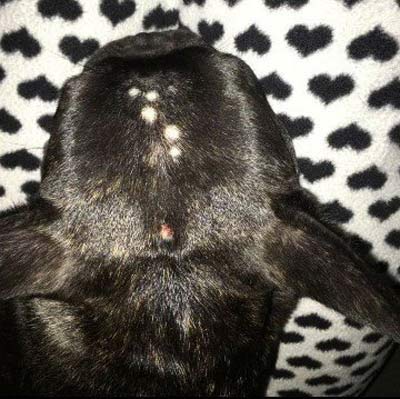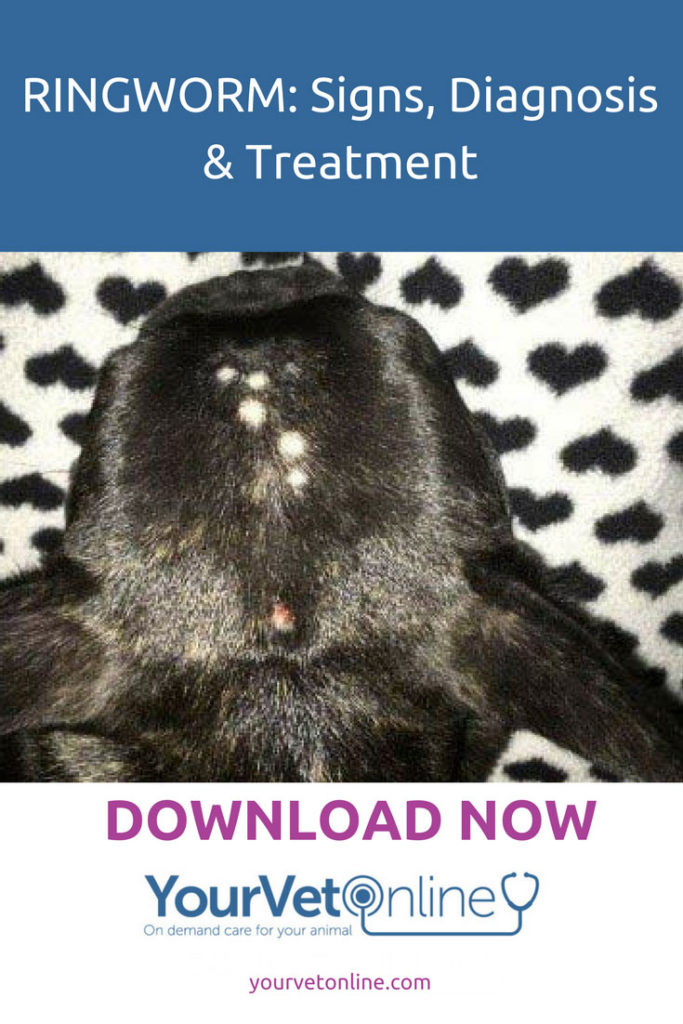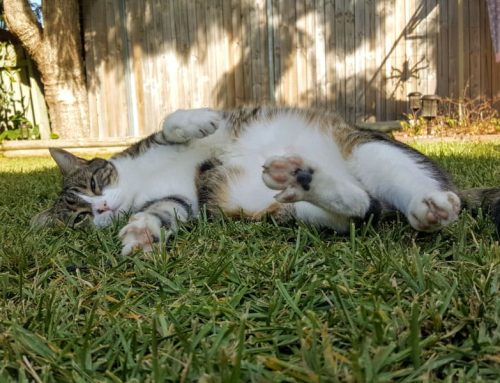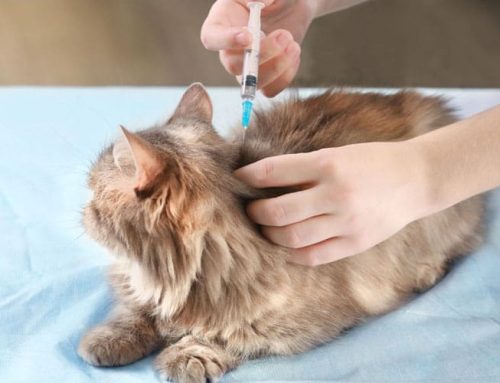How To Spot Ringworm In Dogs And Cats? Signs, Diagnosis & Treatment
You see the classical circular bald spot on your pet….eek could it be ringworm?
Ringworm in dogs and cats is a highly contagious fungal skin disease of the superficial layers of the skin, hair and nails, that whilst relatively harmless to the pet, can spread to humans, particularly those who are young, old, or immunocompromised (such as when undergoing treatment for cancer).
This common skin infection can also be a particularly frustrating disease to treat especially in breeding or rescue cat populations or pets with long hair coats.
In this article, we will discuss how ringworm on dogs and cats is diagnosed and provide options for treatment and prevention.

Telltale signs of ringworm are bald circular patches in an animal’s coat. In this instance, on this dog’s head.
What Is A Ringworm Infection?
Why this skin infection is called ringworm is kind of bizarre, as there are no worms involved.
The name occurred due to the ring-like appearance of lesions that show on an infected animal.
Ringworm is a fungal infection caused by a fungus known as dermatophytosis.
There are different species of ringworm, the most common culprit we see we see affecting dogs and cats is Microsporum canis (M.canis).
Ringworm infections are frequently seen in cats, dogs, horses and cattle.
The most common species of dermatophytes isolated according to animal species are:
Cats: Microsporum canis, Trichophyton mentagrophytes, M. gyspeum
Dogs: Microsporum canis
Horses: Trichophyton equinum, Microsporum canis, Trichophyton veruccosum
Cattle: T. veruccosum
Ringworm often occurs in the very young, the very old and the immunocompromised.
Ringworm is not a bacterial infection and the use of antibiotics in its treatment is therefore not indicated.
What Are The Signs Of Ringworm?
Ringworm is often diagnosed by the telltale clinical signs of bald circular patches of hair loss on an animal’s coat.
In this picture, the ringworm lesions are on this dog’s head.
The affected area may be crusty and have scaly skin and broken hairs, but generally, it is not itchy or painful, just unsightly.
Initial ringworm symptoms include an area on the coat with raised hair, this hair can be ‘plucked out’ easily leaving a bald (alopecia) area.
Sometimes these areas of skin are red and inflamed, however, this usually resolves quickly.
Some animals can harbor ringworm and show relatively few signs, effectively being asymptomatic carriers of infection.
This is particularly common in cats and if an infected cat enters a colony it can result in massive contamination of the environment with fungal spores.
How Is Ringworm In Dogs & Cats Diagnosed?
The initial diagnosis of ringworm is not particularly tricky, although the scaly patches can mimic some bacterial infections and parasitic diseases such as Demodex.
It is worthwhile getting a formal diagnosis due to the zoonotic nature (that is, ringworm fungus can be passed on to humans and infect us).
In the case of breeding operations and animal rescue centers (particularly those that house cats), it is absolutely imperative that a formal diagnosis of any suspicious lesion is performed, as this skin disease can result in unmanageable outbreaks, excessive costs, and euthanasia due to its potential to spread to people (zoonosis).
The initial test that most vets will perform is the examination of skin lesions with a special ultraviolet light called a Wood’s Lamp in a dark room.
On close examination of plucked infected hair and skin cells, a positive result will appear as a fluorescent ‘blue’ colour.
It should be noted that environmental contaminants and some topical medications can also fluoresce.
Although not a perfect diagnostic test due to the relatively high frequency of false-negative results, examination of hair and skin under a Wood’s lamp – correctly used – can be a helpful and cost-effective screening tool to determine if ringworm spores are present.
A negative Wood’s lamp examination does not, of course, rule out an infection (only around 50% of cases of M.canis infection will fluorescence) so suspicious lesions should have additional testing of a sample of hair shaft including the hair follicles examined under the microscope and/or be sent for fungal culture.
Ringworm Treatment
Treatment of animals and environmental management of ringworm need to go hand in hand when there is an outbreak of ringworm.
Whether you are treating the skin condition of dogs, cats, horses, or other species the principles are the same.
As mentioned earlier, it’s important to understand that ringworm can infect people (animals to humans zoonosis), particularly those that may be immunocompromised.
For this reason, it is essential that you treat any animals with signs of this infection and use personal protective clothing yourself when handling these infected animals.
It’s also very important that you practice excellent disease control with quarantine and isolation of infected animals so that they do not infect others.
The environmental spread of ringworm can be reduced by minimising direct contact between infected animals and practicing strict hygiene and environmental decontamination.
Depending on the severity of the disease effective treatment of ringworm may consist of a combination of topical therapy and systemic oral medications.
The most important component of treatment is topical therapy.
Topical Antifungal Treatment
Part of the treatment strategy for ringworm infections can include the use of topical antifungal shampoo as well as topical antifungal creams.
Lime Sulphur (lime sulfur) – 8% topical therapy is an incredibly useful topical treatment. It has residual activity and can assist with ‘clearing’ of infection in the environment.
- Safe to use in kittens and puppies (after applying, make sure to keep them warm)
- Apply twice weekly to cats and dogs. Horses apply daily initially, and then move to twice weekly in the second week.
- Apply powder then spray with water. (Don’t pre-wet). Wipe paste over facial areas (nose, ears etc) avoiding eyes.
- Leave to soak into skin and hair, there is no need to rinse off.
- Continue treating until you have two consecutive negative fungal cultures a week apart. (It is common for cats especially to appear ‘cured’, when in fact they are still highly contagious).
- Spot application is recommended – you don’t need to apply all over the entire pet, applying only on the affected areas will do.
Iodine – doesn’t work nearly as well as lime sulphur, often being ineffective.
Chlorhexidine-medicated shampoo – is not effective against fungal spores.
Topical creams that are useful include ingredients such as clotrimazole, terbinafine, or Miconazole.
Systemic Treatment Of Ringworm
Oral antifungal medication is often used in situations where it is difficult to wash infected animals, topical treatments aren’t working, or if the animal is severely affected and it’s difficult to get to deeper areas of the hair follicle where spores are often found.
Oral antifungal drugs act by killing fungal cells directly or by preventing fungal cells from growing and thriving.
Be mindful that these prescription veterinary medicines cannot be used in pregnant animals due to the risk of toxicity to the foetus and will often need to be compounded to get the small dose required for small kittens and puppies.
Many of these oral antifungal drugs are more effectively absorbed from the gastrointestinal tract when given with fat such as butter.
Systemic therapy with oral medications often requires 6 weeks of treatment. Testing is recommended after this period with a further two weeks of treatment given to ensure all skin scrapings are negative.
Drugs that have shown to be effective for ringworm treatment include:
- Itraconazole – relatively safe, has a long half-life in skin.
- Fluconazole
- Terbinafine
- Griseofulvin – although effective it has more toxic side effects than itraconazole.
- Ketoconazole – avoid use in cats due to hepatotoxicity (toxic to the liver).
Environmental Contamination Management Of Ringworm
Because ringworm spores can survive in the environment for many years, it is imperative that environmental cleaning is part of your management strategy.
Keeping infected cats or dogs in one room – effectively quarantining them, will help to limit contamination and make decontamination easier.
Remember that any bedding, baskets, collars, leads, and grooming equipment are all sources of potential contamination.
Removal of fungal spores from the environment can be achieved by firstly vacuum cleaning to remove as much dirt, debris, and spores as possible first, then surface disinfection.
Remember that the vacuum bag will need to be destroyed (burned) as this can be a future source of spores.
Hypochlorite (bleach), glutaraldehyde solutions, or accelerated hydrogen peroxide are the most efficacious against fungal spores. (Check with a vet if you are unsure of the product’s safety around pets).
It’s important to thoroughly follow label instructions to ensure that the product is effective against spores.
Note that bleach solution (1:32 dilution) requires a prolonged contact period of at least 10minutes before being thoroughly washed down with fresh water.
Grooming equipment is either bleach cleaned multiple times or thrown out and burned.
Food bowls can also be a source of infection if not cleaned regularly in a high heat dishwasher.
Bedding, blankets and toys can play a huge role in maintaining infection.
It’s important to wash these regularly, preferably on days that topical treatments are applied.
Items that cannot be easily washed need to be thrown away.
Prevention Of Ringworm
Ringworm is a condition that most often affects those that are mal-nourished, have concurrent disease, internal or external parasites and/or are living in crowded situations.
Practicing good husbandry and ensuring animals receive preventative health care and optimum nutrition will go a long way to preventing this skin problem.
Because there are no reliable screening tests or vaccines against ringworm it is wise to avoid mixing young and adult animals from different families together.
Make sure that all newcomers are given a careful visual exam and if any animals have suspicious lesions then they must quarantine in an isolation area.
Have you ever had an animal suffer from ringworm? Tell us below how you managed and treated for it. If you require additional advice on managing a ringworm outbreak our vets are online 24/7.





I need to know if my cat has ringworm and if so can I get the meds prescribe online